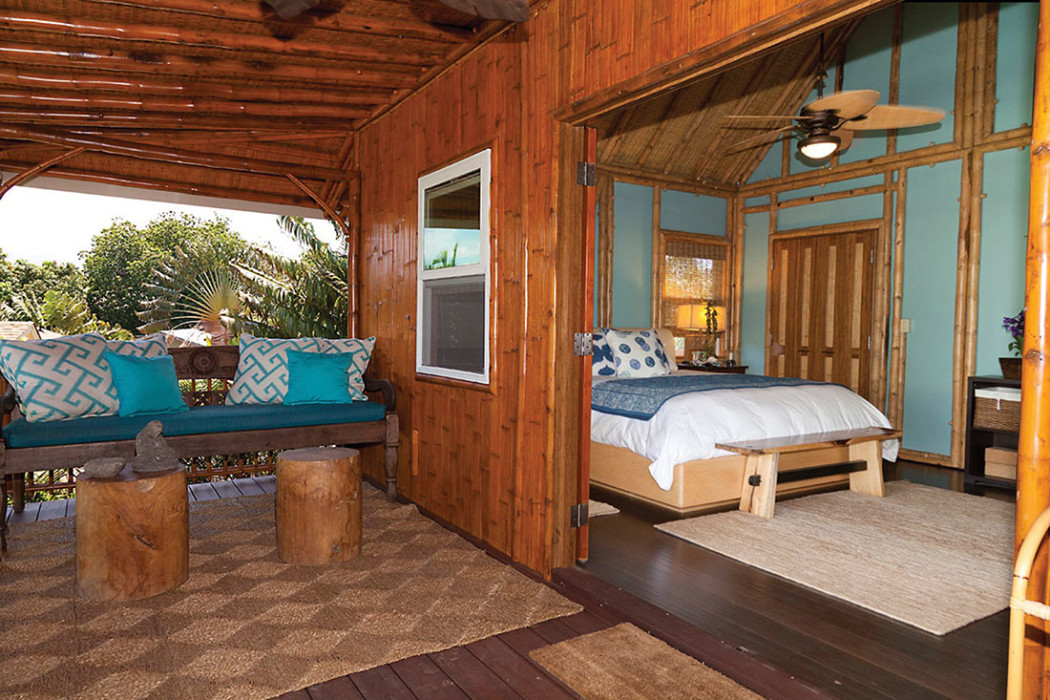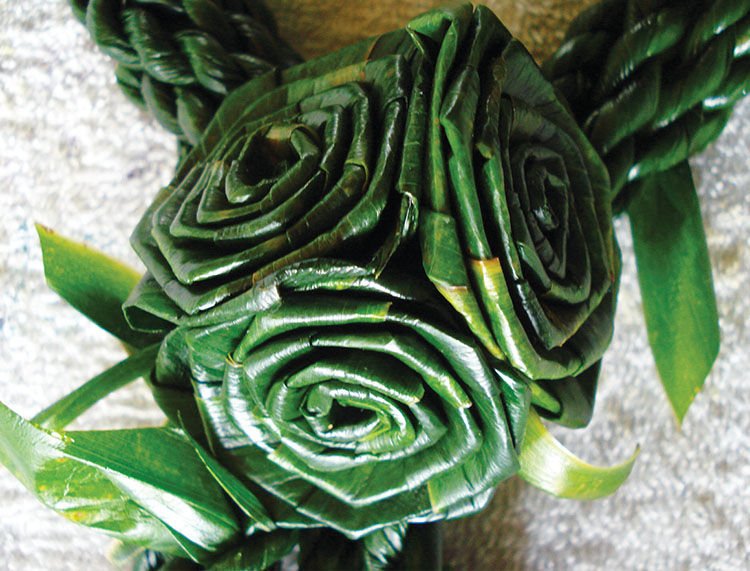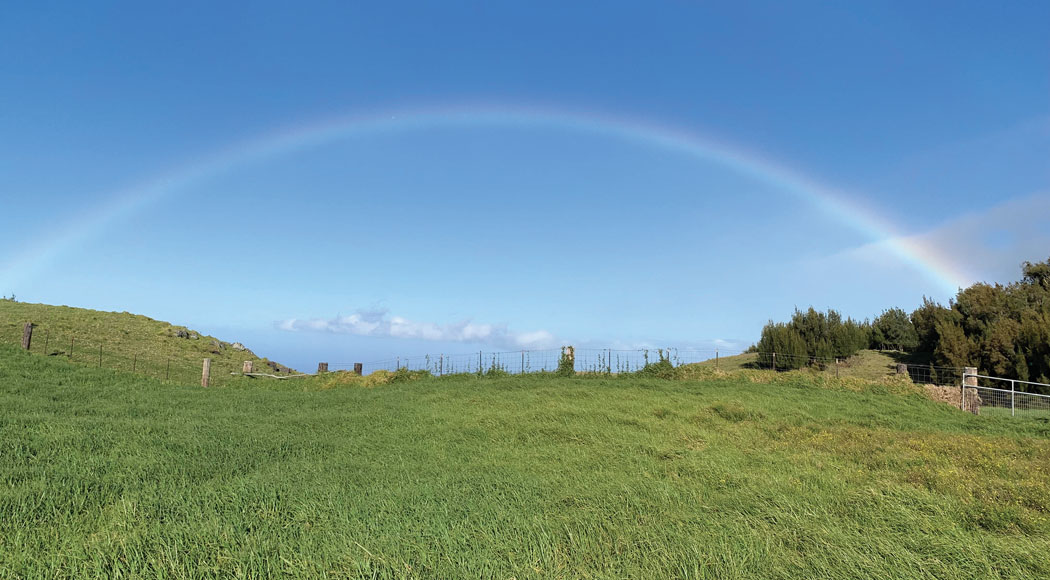
This Old/Beautiful House: Maureen’s Bed and Breakfast
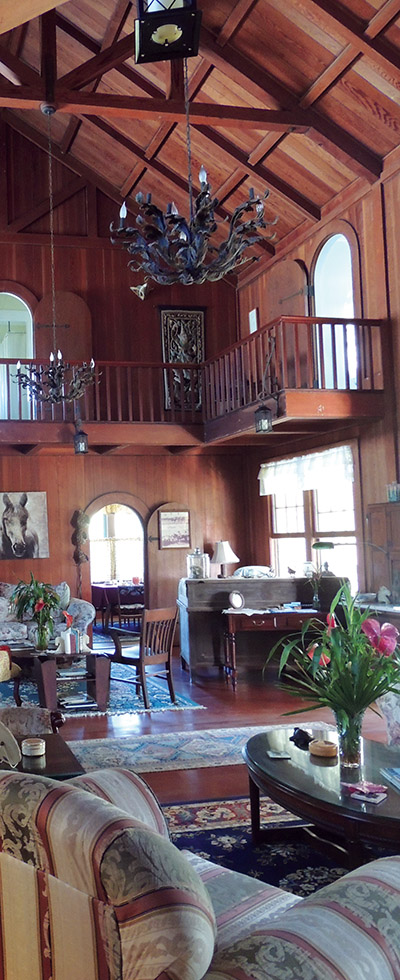 By Paula Thomas
By Paula Thomas
Tucked away behind dense jungle foliage and invisible from Kalanianaole Street in Keaukaha is one of the most architecturally interesting homes in Hilo.
Known to some as the Saiki home, today it is Maureen’s Bed and Breakfast and has been functioning as a haven for island travelers since 1979. Owned and operated by Maureen Doto, a native of Baltimore, Maryland, the B&B has evolved steadily over the last 25 years into a totally charming, quiet, restful, coolly spacious home where clearly everywhere you turn, east coast vintage is splashed with traditional Asian and south sea island.
The house has beautiful bones. Stunning, in fact. The two-story great room, into which beams the sun from the south-facing pairs of arched windows, is built the way a ship is. Thirty-foot boards of salt-treated redwood (they were floated in alongside a barge), set in a tongue-and-groove fashion and stained to perfection, line the rectangular central space. You can’t help but experience the dwarfing verticality. Yet, among the first things you feel in the open space is how comfortable and welcoming the two-story great room feels.
The next eye-catching wonder are the gorgeous arches in the banisters on the symmetrical staircases that lead up from left and right of the great room to the east and west-facing bedrooms on the second floor. Each wing has separate access and comprises corner bedrooms on either side of a central bathroom. On the north side, two small bedrooms accessible from the balcony accommodate single travelers. In the original home, this was an open-space walkway to connect the east and west wings.
It’s a unique and singularly accommodating layout, especially for the original owners, Takaichi and Mary Forbes Saiki, who had eight children (although not all of them grew up in the residence).
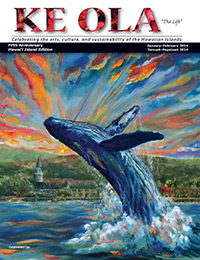
The house was designed by Frank Futoshi Arakawa in the 1930s, one of several residential architecture commissions he completed in Hilo in the years before WWII.
There’s a touch of playful sophistication in the house, in the way Arakawa divided the second floor, in the arched doorways that lead beyond the great room to the bedroom areas. It’s efficient, artful, and laid out in a way that supports togetherness as well as privacy. Overall, the house had seven bedrooms, five baths, and two kitchens (one on the ground floor).
Today, the layout transfers well for Maureen’s guests who hail from all over the world. On the first floor, two bedrooms and one bath on the east side sit directly underneath a similar layout upstairs. On the west side, the dining room that seats 10 and the kitchen behind it where Maureen cooks everyone breakfast sits underneath the two-bedroom/one-bath arrangement on the floor above.
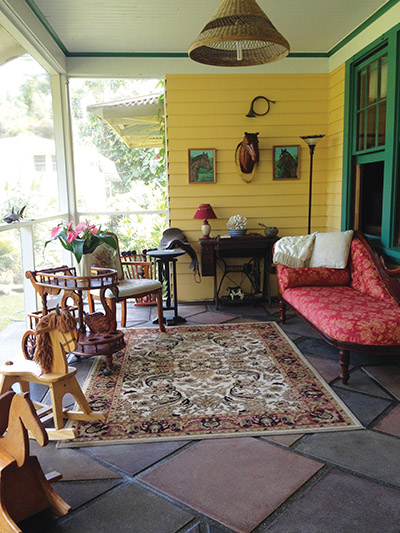
Pancakes and waffles are a specialty of the house, along with fresh fruit and Hawaiian coffee. On the grounds beyond the kitchen and parking area grow an array of fruit and old hardwoods like black walnut, black pine, and cypress. Any fruit in season is gathered for the breakfast table.
The charm of the home stems from the simple yet thoughtfully placed architectural detail that directs your eye to points of interest. Everywhere you look there is some detail in the wood to ogle if you care to look hard. The 80-year-old 30-foot-long boards that make up the walls have been unyieldingly sturdy and locked tight since they were installed. The floors are dark-stained fir and, according to Maureen, get polished every other day along with the walls. The overwhelming use of dark wood and ample second-story windows keep the central space cool without the need for ceiling fans.
All the hinges and hardware are black forged metal—the type of hardware you might see in medieval structures. They almost seem to hold the door seams in place and are quite an unusual element for a tropical residence.
A View From Every Vantage Point

It’s a delightful feeling, looking through arched doorways from the great room and into the remodeled, pastel-colored bedrooms outfitted with quilts and lace and antiques. It is fun to run your hands along the whimsically graceful lines of the carved banisters—or just appreciate them as they catch the midday light. The wood detail here came at the hands of the contractor, Sango Kawasaki, well known at the time, as was Arakawa.
Behind the kitchen and overlooking the Japanese garden and koi pond in the backyard used to be a Japanese tearoom. While now a rather conventional TV/lounge area for guests, elements of the once-distinguished tea room are still there: preparation area, cherry wood posts, the raised floor for the tatami mats, and metal slides for the Shoji screens that once enclosed the room.
Perhaps most unexpected are the lavender bath fixtures in what was the master bath—a lavender pedestal sink with matching lavender tub and large-tank toilet. Original to the house, their existence is owed to Mrs. Saiki’s design and taste.
Frank Futoshi Arakawa: a Prolific Architect

Frank Arakawa was born on Maui in 1891. The Arakawa family moved to Hawai‘i Island where Frank graduated from Hilo High School as the first-ever Japanese student. After high school, he served in WWI as a doughboy officer and graduated from Stanford with an engineering degree with a secondary interest in architecture. When he returned to Hawai‘i Island, he worked for the County and eventually became the chief engineer of the Department of Public Works. Married to a Japanese woman with a large family of his own, the Saiki residence was a project that he could have designed as his own residence. It must have been a labor of love for his good friend.

Although he did some stellar and unique residential work and is known for his graceful, sleek pitched roofs, he is perhaps more familiar to many for his contributions during the build out of the island schools and facilities in the late 1920s-30s. The Hilo High School auditorium was built in 1928, designed by Frank Arakawa (an alumnus) and funded with donations from the Alumni Association.
In Pāhala, Ka‘ū High and Pāhala Elementary School, built in the 30s, is a largely intact campus done by Arakawa. He used tongue-and-groove vertical board and single-wall construction on a post and pier foundation, which was typical school construction. As with the Saiki house, he used orientation to capture light: most classrooms face the north to capture maximum light without direct sun, while the south side features the lanai for shade and shelter. The campus is, according to the Historic Hawai‘i Foundation website, “significant as an intact example of the rural school to service the plantation community. This school reflects the time period on the County of Hawai‘i’s building program of rapid expansion in plantation population and therefore educational needs in rural areas of the island.”
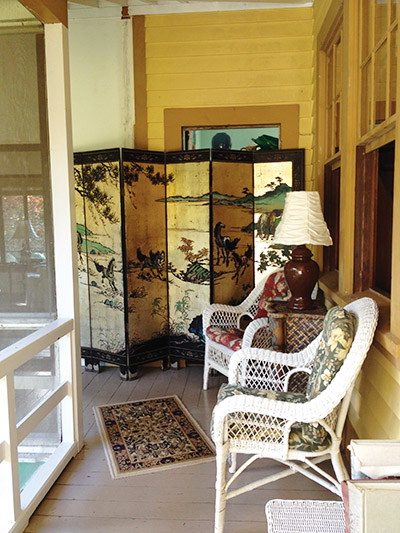 In 1938, Arakawa was hired to draw up plans and specifications for recreational facilities, a bar room, and alterations to the former Harlocker home and grounds. The property, set in Keaukaha, had been secured for the new Hilo Yacht Club. Unfortunately, Arakawa’s structure was lost in the tsunami of 1946, according to Hilo Yacht Club records.
In 1938, Arakawa was hired to draw up plans and specifications for recreational facilities, a bar room, and alterations to the former Harlocker home and grounds. The property, set in Keaukaha, had been secured for the new Hilo Yacht Club. Unfortunately, Arakawa’s structure was lost in the tsunami of 1946, according to Hilo Yacht Club records.
Not long thereafter, during WWII, Arakawa was interred on the mainland, a heavy sanction for his having greeted Japanese dignitaries at Hilo’s Kuhio wharf pre-WWII. The dignitaries had arrived to sightsee at Volcano.
The dislocation ended up being permanent: Arakawa never returned to Hawai‘i Island, but rather, stayed on the mainland and moved to Chicago. He left a legacy through the service he provided to Hawai‘i County as architect and engineer and in the many educational and municipal structures he designed that still stand today.
For Maureen’s Bed and Breakfast and the Saiki family, Frank Arakawa has provided decades of memories of life well lived. Maureen uprooted her life in Maryland as an X-ray technician to resettle in the idyllic, close-to-nature life that Hilo beckoned so many years ago. Friends and fate brought her to the house she now runs as a bed and breakfast.
Today, people from all over the world looking for the homey accommodations offered by B&Bs wax enthusiastic over the charm and peacefulness of Maureen’s Bed and Breakfast. One thing the beautiful old Saiki house is still providing is lasting memories for all who still pass through the front door. ❖
Citations:
HiloYachtClub.org/documents/History%200507.pdf
HistoricHawaii.org/Historic_Properties/Hawaii_Non_Residential/Hawaii_Pahala_KauHighandPahalaElementarySchool.html
Photos courtesy of Maureen Doto and Crosby Reed: mimosahillsfarm@yahoo.com
Contact Maureen’s Bed and Breakfast: MaureenBnB.com, 808.935.9018
Contact writer Paula Thomas: paula@delphipacific.com
